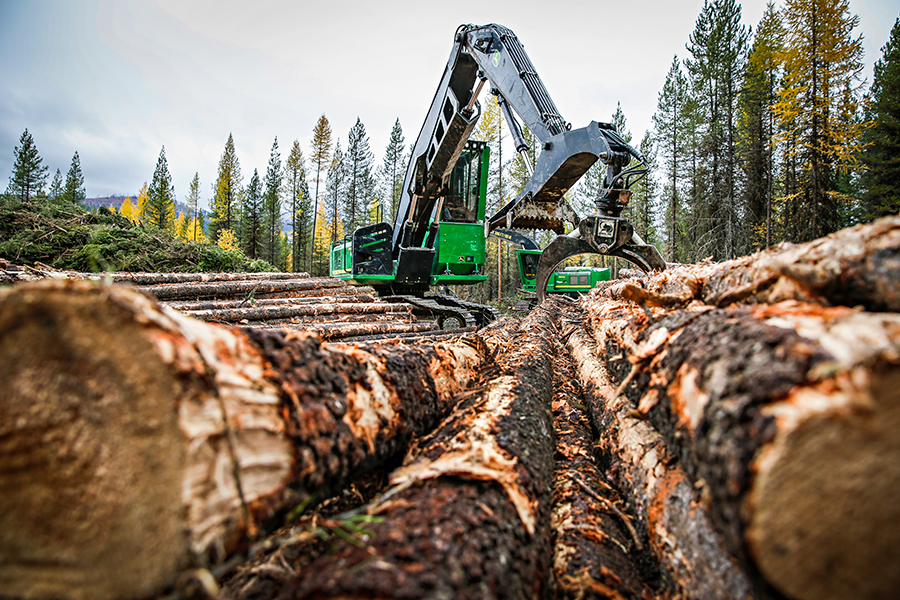Pandemic Impacts Slower to Reach Treasure State Timber Industry
Although timber and construction were among least-affected industries, uncertain economic times remain in forecast
By Tristan Scott
In Montana, unlike many other states, the construction industry was allowed to operate during the lockdown while timber workers who keep the forest products inventory flush were already anticipating a lull in logging during the nascent days of the COVID-19 pandemic, a traditional seasonal slump known as “spring breakup.”
So as building projects already slated to move forward did so, and as loggers and mill workers settled into an anticipated spring slowdown while the forests dried out from winter, no one lost their jobs — hammers kept swinging and saws stayed sharpened, with plenty of timber harvests waiting on the horizon.
But just because the industry dodged the first waves of the pandemic’s short-term impacts doesn’t mean trouble isn’t trailing far behind, particularly in rural economies, according to industry experts.
“When you’re dependent on one or two primary resources, even minor downturns can wreak havoc,” Laura Schweitzer, executive director of the Council of Western State Foresters/Western Forestry Leadership Coalition, said during a Western Governors Association webinar last week. The topic of the webinar was “Restarting Resource-Dependent Economies” and panelists focused on how the COVID-19 pandemic is impacting timber-dependent communities in the West.
“The COVID-19 pandemic is presenting challenges that go beyond economic challenges,” she said. “It’s things like social distancing rules when you’re trying to meet collaborative goals, or how to get work done on the landscape when you’re struggling to get help from agencies with limited activity or budget cuts.”
Those complications could start to gum up operations across the West, particularly if the pandemic creates a backlog of bureaucratic delays and stalls enough timber sales, according to Wes McCart, a county commissioner in Stevens County, Washington, who served as a panelist on the webinar.
For example, McCart said state safety advisers in Washington are trying to determine whether work can resume in the woods without increasing health risks.
In Montana, the state Department of Natural Resources and Conservation had delayed its Best Management Practices audits of forest workers due to an inability for agency inspectors to share vans to worksites or be in close physical proximity to one another. In Washington, McCart said plans to furlough state workers at least one day a week could further delay permitting and analysis work that is required before private crews can move forward on projects.
“The Forest Service is telling us they won’t be planting any trees, and they’re not doing any slash-burning this spring or fall,” McCart said on the webinar. Leaving dead fuels on the ground can lead to fire or bug infestation problems, while mobilizing crews for fuel reduction work can trigger COVID-19 outbreaks, creating a classic catch-22 dilemma.
Montana does not have plans to furlough state employees, according to Gov. Steve Bullock’s office, and the state’s cooperative Good Neighbor Authority agreement with the Forest Service has not delayed any projects at this point.
Still, the nationwide housing construction forecast has fallen from a predicted 1.6 million starts in 2020 to about 800,000 for the year, according to Schweitzer. That’s an improvement over the levels that followed the 2008 economic crash, which saw about 600,000 starts, she said, but not the groundswell forecast at the beginning of 2020.
To calm some of the economic turbulence, the U.S. Forest Service allowed mills with existing contracts accepted before April to delay action for up to two years.
According to U.S. Sen. Steve Daines, R-Montana, who pushed for the two-year extensions, it helps minimize the disruptions to the wood products industry and the rural economies it sustains.
“It is critical the agency allows ongoing sales to continue and provide contract relief to ensure timber purchasers are not forced to comply with provisions that do not reflect the changing market,” Daines wrote in a letter to Agriculture Secretary Sonny Perdue.
The economic ripple effects will likely continue to disrupt the natural resources industry beyond 2020 — kinks in the supply chain, virus-related safety restrictions, and the unforeseen fallout from forest fires and drought all increase the chances for further interruptions.